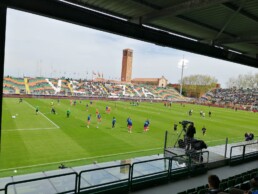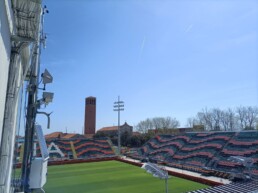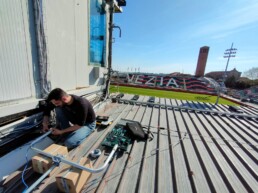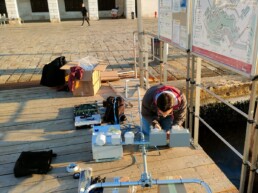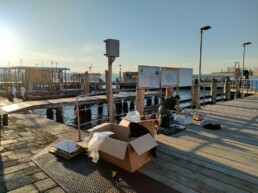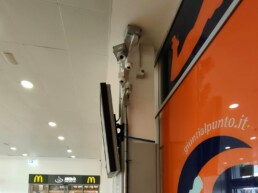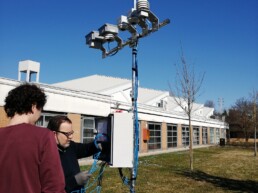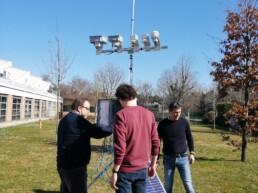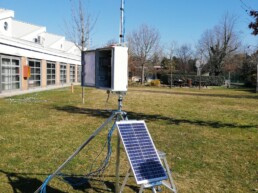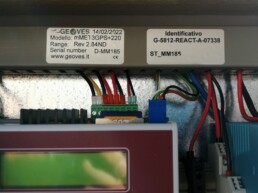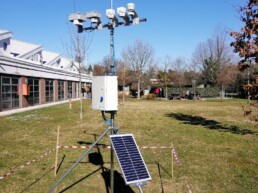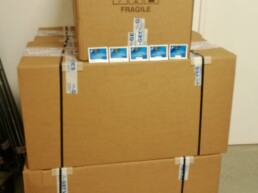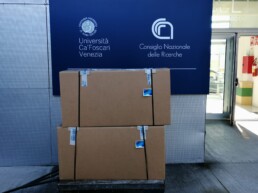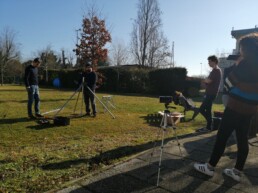NATO Allies Committee meets with REACT researchers in Brussels
A delegation from REACT was invited by the Science for Peace & Security Programme (SPS) Emerging Security Challenges Division (ESCD) directorate to present its achievements. In a Brussels that was armored due to a terrorist attack in conjunction with the Belgium-Sweden soccer match, permanent diplomatic representatives to NATO met with researchers from the REACT project who presented possible applications of the platform.
In Tbilisi the 3rd REACT meeting "Towards an autonomous implementation of the REACT platform"
After meetings in Rome (December 2021), Venice (October 2022) it will be the Georgian capital that will bring together the REACT Research Group, a group increasingly motivated to take to the highest operational level a platform already proven in a dozen different contexts, from St. Mark's Square to Tbilisi Botanical Garden, from soccer stadiums to elementary school...
An ambitious and well-organized program by Ilia State University in which the results achieved were discussed with Scientists and Diplomats.
Practical internship on securing linear outdoor sporting events
Close to the border with the former Yugoslavia, a border that until 1989 also represented the point of contact between the Atlantic Alliance and the Warsaw Pact, along the so-called "Iron Curtain," were the 24Ore Business School Students after the positive experience of the previous year in Friuli Venezia-Giulia. Various activities during the international bicycle race "Gran Premio Val Degano" with departure from Udine and arrival in Sappada, where the potential of monitoring through the REACT platform was tested.
With exactly one year to go before the start of the competitions, REACT introduces itself to the Organizing Committee of European Athletics 2024
Presented in Rome at the historic FIDAL offices the REACT project. An afternoon of high education during which the Italian and U.S. researchers of the SPS project met with the management of EuropeRome2024. An event the one in Rome during which the best athletes of the continent will compete at the Olympic Stadium, in the Foro Italico park and in some streets of the Capital, 50 years after the 1974 Rome edition, a logistics that lends itself well to monitoring through the REACT platform. The European Athletics Championships will precede the Paris Olympics by a month and a half, with an expected audience of 300,000 viewers and a global TV audience of 750 million.
SPS NATO program presented to future Sports Managers at 24Ore Business School in Milan, Italy
Among mass events, sports events, both indoor and outdoor, are those with the most critical security and monitoring issues. Thanks to the willingness of REACT partners at the University of Oklahoma, after some remote seminars, some in-person seminars will be held during the XXVII Master's program "Sport Business Management." (PROGRAM). Thanks to the monitoring carried out in cooperation with Venezia F.C. during 2022 (Serie B Championship) about fifty future Sports Managers will be able to increase their knowledge on securing sports events through the REACT platform.
Leaving for Tbilisi REACT units: new risk management tools in the Caucasus area
With cargo TK1868 from Venice to Istanbul and then destination Tbilisi with flight TK6166, the REACT project in the Caucasus area comes into full swing. Customs practices permitting, from January the Ilia University research team involved in the training activities recently carried out in Italy will start the installation of the 4 control units in some sensitive points in Tbilisi. By Q1 2023, the REACT network of control units will be fully operational between Georgia and Italy, allowing the comparison of social and environmental variables in different geo-political contexts.
Over a hundred Researchers and Students in Venice for “Intermediate-training meeting: towards an interactive development and social spreading of REACT platform” among science, art and sports
From the medieval cloisters of the Vivaldi Hall to the Penzo Stadium, guests of Venezia F.C., the REACT project passed the calibration phase of the 6 Power Units meets the international scientific community, institutional stakeholders, the world of school and sports in a three-day event distributed around the lagoon city. The contribution of Art (visual arts and music) will not be missing to make concrete that "social spreading" that Science for Peace and Security projects, must guarantee.
Here is program of the meeting.
Successfully monitored Venezia-Atalanta (34th day of Italian Serie A)
Despite a 3-1 defeat on the pitch, Venezia F.C., at whose 'Pierluigi Penzo' stadium the match against Atalanta was played, has certainly won the record of the most technologically advanced club in the top Italian football league. From 15 April to 30 September, a REACT control unit will be operational in the iconic football pitch surrounded by the greenery of the Giardini di Sant'Elena, just a few metres from the Biennale pavilions. The location was chosen by the CINSA researchers both for the specificity of the sports facility and the dynamics of an indoor mass event with thousands of fans concentrated in a short time and in a limited space, and for the possibility of intercepting millions of people from all over the world visiting the 59th International Art Exhibition of Venice.
The testing step starts for the six REACT stations
The six REACT stations have been installed near one of the Venetian ARPAV monitoring station.
This first step will allow Italian scientists from Ca’ Foscari to test the instruments and to validate the correct functioning of the installed sensors. During the next testing month, the six monitoring stations will register lots of information about the environmental conditions: atmospheric pollutants (PM 1, PM 2,5, PM 10), the ambient noise, the nitrogen dioxide and the sulfur dioxide. Other important measurements will be about the wind speed and direction, humidity and temperature.
All those information will be crucial for the REACT project: after the first testing step, units will be ready to be installed in various places in Venice.
REACT control units now available at Ca' Foscari University Campus
After a pre-testing phase guaranteed by the supplier, the REACT stations have started to measure the first parameters in the classrooms and laboratories of the Venetian university’s Scientific Campus. These stations are already measuring meteorological and environmental parameters in Turkey, Romania, Belgium, Iraq, Germany, Jordan, Saudi Arabia and, in a few months, Georgia. These are the ten parameters measured:
- Fine dust PM 1, PM 2, PM 5, PM 10 (low resolution);
- Barometer range 800/1100 hPa
- Sulfur dioxide (SO2 high resolution)
- Nitrogen dioxide (NO2 high resolution)
- Sound level probe (30/120 dB low resolution)
- Wind speed (0/75 m s-1)
- Wind direction
